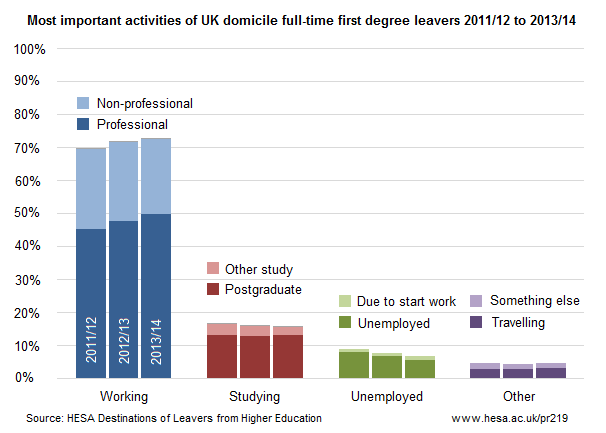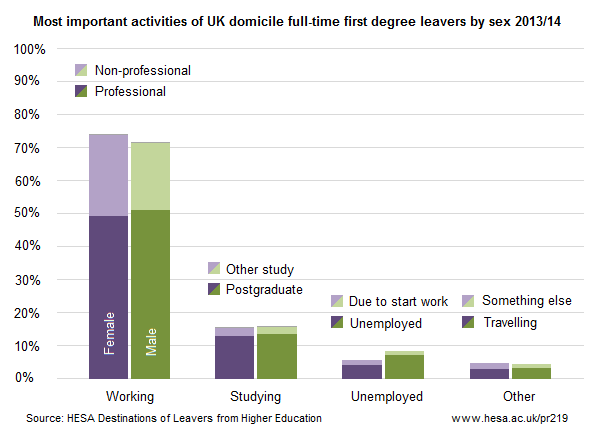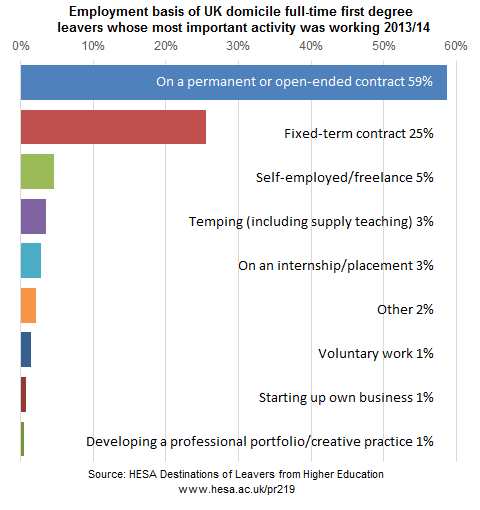What 2013/14 graduates did next
HESA publication 'Destinations of Leavers from Higher Education 2013/14' released.
The publication, released on 23 July 2015, provides extensive coverage of the 2013/14 DLHE survey. The online introduction includes a variety of graphs and tables displaying the survey results.
Survey respondents are able to report all the activities they are engaged in six months after graduation, and to report which one was the most important to them. The charts below look at the most important activities (according to their own assessment) of UK domiciled, first degree graduates who studied full-time.
Rise in professional employment, fall in unemployment
73% of 2013/14 UK domicile full-time first degree graduates said that working was their most important activity, up from 70% of 2011/12 leavers. Of those working, 69% were in professional occupations, compared to 65% two years ago.
16% gave further study as their main activity, of whom 85% were involved on a postgraduate course (as opposed to seeking a professional qualification or no qualification).
7% of 2013/14 UK domicile graduates from full-time first degree courses were unemployed, of whom 19% were due to start work within a month of completing the survey. The proportion of leavers unemployed has fallen from 9% of 2011/12 graduates, of whom only 13% said they were due to start work.
5% of survey respondents did not fit into any of the above categories. The majority of these leavers were taking time out to travel.

Underlying data in tab 1 of DLHE-Press Release Tables.
Male graduates more likely to be unemployed
Female survey respondents were more likely to be working, and less likely to be unemployed than male respondents. 74% of female graduates were working compared to 71% of male graduates. Furthermore, 6% of female graduates were unemployed compared to 8% of male graduates. However male graduates were more likely to be employed in professional occupations (51%) than female graduates (49%).

Underlying data in tab 2 of DLHE-Press Release Tables.
Of those in jobs, 59% on permanent contracts
The survey also asked graduates about the basis of their employment. Of those UK domicile, full-time, first degree leavers whose most important activity was working, 59% were employed on a permanent or open-ended contract, 5% were self-employed or freelance, and 1% were starting their own business. 3% of working graduates were on an internship or placement.

Underlying data in tab 3 of DLHE-Press Release Tables.
Destinations publication
Destinations of Leavers from Higher Education 2013/14 provides detailed information on the activities of students 6 months after leaving higher education. The 51 tables in the publication (see contents list) include activity and employment breakdowns by:
- HE provider
- Level and mode of qualification
- Sex
- Age
- Disability
- Ethnicity
- Class of first degree
- Subject of study
- Occupation
- Industry
- Location of employment
- Salary
Destinations of Leavers from Higher Education 2013/14 is available to purchase now from our site.
The free online introduction to the publication includes sector level tables and charts covering various aspects of the survey results.
More results of the 2013/14 DLHE survey can be found here.
Notes for Editors
- Press enquiries should be directed to:
- HESA Press Office
- 01242 211120
- [email protected]
- 95 Promenade, Cheltenham, GL50 1HZ.
- The HESA Destinations of Leavers from Higher Education (DLHE) survey asks leavers from higher education what they are doing six months after graduation. Further details about the survey, including the full survey questionnaire, can be found via this web page.
- Definitions of the terms used in this press release can be found here
- The charts above relate to all UK HE providers. The figures behind the charts, and those for the individual nations of the UK, are available in this Excel file: DLHE-Press Release Tables.
- In the data tables 0, 1, 2 are rounded to 0. All other numbers are rounded up or down to the nearest multiple of 5. Percentages in charts are calculated on un-rounded numbers.
- "Other study" includes Professional qualifications, First degree (e.g. BA, BSc, MEng etc.), Other diploma or certificate, Other qualification and Not aiming for a formal qualification.
- Leavers whose sex was either not recorded or not classified as either male or female are included in total figures but not shown separately.
- HESA cannot accept responsibility for any inferences or conclusions derived from the data by third parties.
Ends

Press Officer
